Written by Amanda Jasper, Director of Corporate Communications at NewGround
It’s time to face the facts: your branches do not meet current consumer demands and need a fresh design to remain relevant, retain existing consumers, and attract new ones. But the question is: how do you update all locations with a consistent branded environment? The first step – start with the development of a prototype.
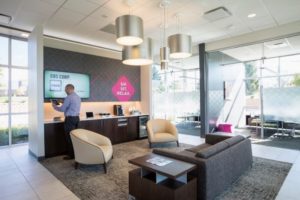
In the first segment of this three-part series, we explored the importance of creating a sound strategic foundation to inform prototype design. Now, in this the second installment of our prototype series, we interviewed NewGround’s Tom Auer, Senior Vice President of Design, and Scott Florini, Vice President of Strategy, to explore how strategic design and methodology brings innovation to prototyping.
Understanding Our World
Having already developed the strategic foundation, the next step is to design an environment that brings that strategy to life. It is important to utilize an integrated project development team to include your project architect, retail and interior designers, and environmental specialists who are able to translate your strategy into a dynamic experience that aligns your brand with the physical presence.
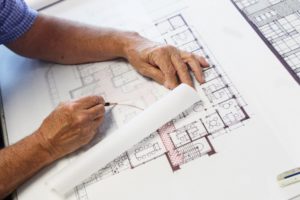
“Understanding current market trends and conditions and how they influence design is critical to successful prototype development. It’s important to have a design partner that is plugged in and has in-depth knowledge of industry trends to provide this valuable insight. This strategic framework will inform prototype design as new and innovative ways to deliver consumer experiences,” said Tom Auer, Senior Vice President of Design at NewGround.
Our world is constantly changing, so assessing the world around us will help guide decision-making, ultimately influencing design. Design and the resulting prototype development process is not a static event – these are retail experiences that are constantly evolving, and thus, design needs to continuously adapt to these changes. The right design methodology should be to keep things fresh by improving the design one site at a time based on new information and circumstances. It is certainly important to reference and apply the prototype design to each future project; however, since there is a wide array of legacy sites that are rarely are identical, you need to strategically adapt and apply the prototype design to each subsequent application.
“You also need to thoroughly test, and value-engineer your design and retail elements before they are rolled out. Successful implementation across multiple locations is all about carefully project managing the application of these retail elements,” said Tom.
“The strategic process informs design and its subsequent kit of parts,” said Scott Florini, Vice President of Strategy at NewGround. “You apply prototypical elements throughout your locations and scale them subject to market, consumer, and return-on-investment criteria. However, the strategic objective is always the same, which is to have all future branches and legacy site applications to consistently look and feel like the prototype.”
Flexible Solutions
Throughout the design process, it is important to remain flexible. New technologies, consumer behaviors, and preferences are rapidly evolving, resulting in the branch needing to adapt to these changes for the experience to remain relevant. The ideal prototype design must provide total flexibility so that future iterations can quickly adapt.
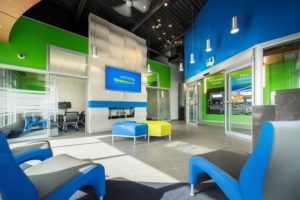
“A good mantra to have is flexibility,” said Tom. “Two decades ago, branch design didn’t change very frequently or as dramatically as we are experiencing today. Once the role of the branch evolved from being a transaction center to onboarding new consumers, with complex sales and service, the design has had to be more flexible to allow for these adaptations.”
Flexibility and future-proofing the design go hand in hand. Designing for the next generation of space also requires an element of modularity in order to stay relevant as times change and needs change.
“Building flexibility and future-proofing space reassures that you can adapt easily to market, technology, or consumer behavior changes,” said Tom. By having a flexible and constantly evolving prototype design, it will better support changes in your business strategy, providing you with greater long-term success and return on investment.
“Flexible designs are derived from making important strategic decisions supported by quantitative and qualitative data. Research and analytics are the foundation from which your design strategy should be built,” said Scott.
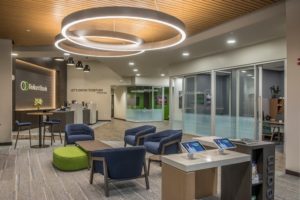
Creating the Perfect Storm
Designing a prototype is an extensive and lengthy process. This process also requires all key stakeholders within the organization to participate in the development of the strategic vision of the design. Before creating any solution, you must first clearly define strategic expectations to ensure your stakeholders are aligned and supportive of the business strategy. Without the contribution and eventual support of the entire leadership team, you will greatly reduce its overall impact of your success and return on investment.
“It is important to understand that prototype development is far more complicated than designing for a single new site,” said Tom. “Prototyping will impact all future and existing locations, so you must establish strategic design objectives for new branches and legacy locations as you apply it across the entire retail delivery network.”
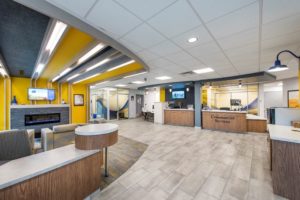
“Once specific retail design elements are aligned with your business objectives across all branches, you will exude brand and performance consistency,” said Scott. “It is important to ensure designs for new sites and refreshed existing locations parallel each other to reinforce brand standards and core service offerings, which will impact each location’s success.”
However, before you implement the application of the retail elements defined by your prototype, you must first assess the design to ensure it is scalable across multiple locations. “Failure to thoroughly evaluate and value-engineer the design before it is rolled out is a common mistake that many organizations make,” said Scott.
In addition, deciding which legacy locations will have the prototype design applied to them is another critical decision. Business fit, market potential, and performance modeling should be the framework from which an organization should prioritize their locations. Once all locations have been ranked from top to bottom, you should then divide branches into tiers that each have a unique application package. The level of investment per site should be based on the anticipated return on investment, with the sites offering the greatest return receiving the most investment, and those with the least return potential receiving little to none.
Adapting the prototype design to meet specific needs and then applying it to the locations that provide the greatest return gives you the power to create the perfect combination to drive success. Now one might ask, how can you also influence staff behavior and how do they interact with consumers in this new prototype? In our final installment of our series, we will take a look at how proactive change management influences the overall culture of your organization, making it the final key element in your prototype’s success.